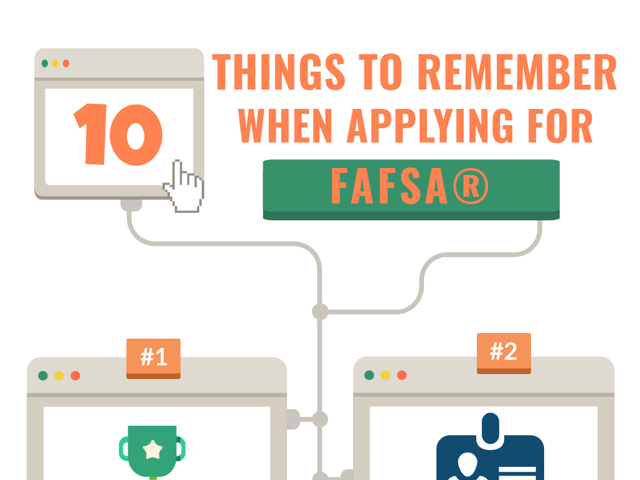
Ten Things to Remember When Applying for FAFSA®
Completing the Free Application for Federal Student Aid (FAFSA®) to determine eligibility for student financial aid can be a complicated process. When completing it online, there are some built-in checks that can help call attention to, and prevent, many errors, but the system can miss some. Errors are even more common on the printed FAFSA®. Here are some suggestions to help you avoid some of the most common mistakes.
1. Complete it as soon as possible. FAFSA® includes many awards that are granted on a first-come, first-served basis—and the sources of some of these may run out of money early. For this reason, it’s important to get your FAFSA® completed as soon as possible rather than waiting for the deadline.
2. Remember to get your FSA ID before attempting to complete the application. FAFSA® applicants need an FSA ID in order to actually complete the application and submit it electronically. This process can take several days, so remember to start this process early.
3. Report all sources of taxed and untaxed income. You can use your 1040 tax form, your W-2 and 1099 forms to determine taxable income, including such things as interest and dividends. Also remember to include untaxed income, such as veterans’ benefits, child support and workers compensation or disability income, if applicable.
4. Read all definitions carefully. Some of the questions on the FAFSA® require information that may not be defined as it would be otherwise. For instance, in families where the parents are divorced, the individual identified as your parent may not necessarily be the one who claims you on their taxes. Read the additional info for each question to make sure that you are providing the correct answer.
5. Be sure to include your parents’ information. Individuals who fully support themselves may think that their parents’ information would be irrelevant; however, “dependency” for FAFSA® is defined differently than by the IRS. If you omit your parents’ information erroneously, your application may not be processed or you will only qualify for some of the assistance types.
6. Be aware of the deadline. Ideally, applicants would complete their FAFSA® as soon as possible, but sometimes that isn’t possible. If this is the case, then be sure that you are aware of the deadline for your school and state. Each one has its own deadline and you don’t want to miss it.
7. Be on alert for predatory websites. The FAFSA® can be completed at fafsa.gov. This is a governmental website that is free to use. However, there are many look-alike sites with similar domain names that charge a fee to complete the application. If you are ever asked to provide account or credit card information, you are on the wrong site.
8. Complete the form in its entirety. Some individuals forego completion of the FAFSA®, thinking that they would not be eligible for aid. The truth is, there is no income cap for student aid and it can often include other valuable opportunities like work-study funding. Other applicants may give up after partially completing the application. While the FAFSA® is a very time and data-intensive form, it is usually worth the effort and time it takes to complete, as it can reveal opportunities you may not discover otherwise.
9. Proofread all of the info for errors. It is common to confuse the parent information and student information sections or overlook a field that needs information. Proofread your application before submitting to ensure that everything is correct.
10. Remember to sign your application. When submitting online, you need your FSA ID to sign, and when submitting a paper copy, you will need to enter your manual signature. The form will not be accepted without a signature.
After submitting your FAFSA®, you can check the status of your application online. This is another key way to ensure that it is moving through the process. If your form is submitted in its entirety, with accurate info, your award letter will arrive much sooner than if you have to re-submit and correct errors.

Keep Reading

Union Test Prep Blog
It’s Almost Test Day—What Should I Do?
You’re approaching the day of your test, and it’s time to take care of …

Union Test Prep Blog
What Are Holistic Admissions?
The term “holistic admissions” alternately garners horrified eye rolls …

Union Test Prep Blog
Ten Tips and Tricks for Successful Test-Taking
While test-taking is rarely anyone’s favorite pastime, the process of t…